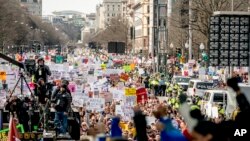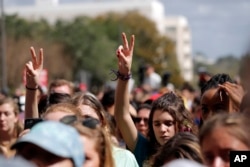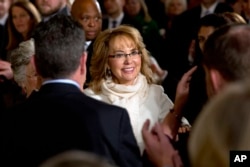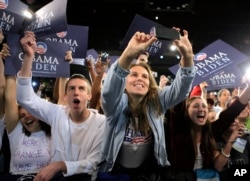They have walked out, marched and demanded action across America to stop gun violence. But it's far from certain that the young people behind the March for Our Lives movement will be a political force at the ballot box this fall.
Republicans are skeptical. Democrats are hopeful. And outside groups that favor gun control aren't taking any chances.
Organizations aligned with Democrats on gun control are spending tens of millions of dollars to ensure that young voters' passion and enthusiasm doesn't fade before the November midterm elections, when the Republican Party's control of Congress will be put to the test.
"Other people look at those young people and think organizing them makes no sense because they don't vote," said Tom Steyer, the billionaire hedge-fund magnate-turned-liberal activist who has committed at least $31 million this year to what is believed to be the largest youth vote organizing effort in American history. "We really believe in this generation."
Past voting patterns show how much work Steyer and others have ahead of them. Just 15 percent of eligible voters between the ages of 18 and 20 cast ballots in the last midterm election.
Still, the mobilization of young people following last month's shooting at a Parkland, Florida, high school has raised the prospect of a shift that could reshape the American political landscape this fall — and perhaps for much longer.
Student leaders from Parkland have already succeeded in keeping the gun debate from quickly fading, as is often the case after mass shootings, though that hasn't resulted in any significant congressional action. Hundreds of thousands of people, many of them in high school, participated in protest marches across the country Saturday. New waves of protests are already being planned for next month.
Their efforts are being aided by powerful groups that favor stricter gun laws. Everytown for Gun Safety, an organization backed by billionaire Michael Bloomberg, expects to spend more money shaping the 2018 midterms than any other election — and much of it on youth engagement, said chief operating officer Matt McTighe.
The organization already spent more than $1 million to help student organizers participate in last weekend's marches. They're now focused on helping high school and college students nationwide organize their own Students Demand Action groups, a spinoff of the organization's Mom's Demand Action against gun violence chapters. Everytown also helped young people establish the nonprofit group that coordinated the weekend marches, while in some cases paying for nuts-and-bolts items like sound systems and stages.
"They've got the energy. They've got the passion. They don't necessarily have the resources or the policy expertise," McTighe said. "We're going to be investing heavily in these students and making sure they engage in politics in every race and every single district across the country."
'Motivation is fleeting'
Additionally, groups backed by Steyer, Bloomberg and former Rep. Gabby Giffords will launch nationwide voter drives on high school campuses in the coming weeks. The operation, according to Giffords' executive director Peter Ambler, will especially target "districts and states where new young voters can have the most impact." Giffords' group, like its allies, will also devote significant resources to sophisticated get-out-the-vote operations targeting young voters.
"They're very powerful right now," Ambler said. "I'm very excited to see what they do with that power."
Republican strategists suggest that the youth movement could prove particularly troubling for their candidates in America's suburbs, where dozens of vulnerable GOP House incumbents already face a wave of Democratic enthusiasm and skepticism from moderate Republicans dissatisfied with President Donald Trump's job performance.
It's less clear whether a surge in youth turnout would sting Republican candidates in Senate races playing out in rural states like North Dakota and West Virginia, where a fight over gun control could motivate Trump's most passionate supporters as well.
Republicans are skeptical that young voters, who typically favor Democratic candidates by large margins, will stay interested.
"Motivation is fleeting," said Republican strategist Chris Wilson.
While equally skeptical about the short-term impact, Republican pollster Frank Luntz warned his party that a mass migration of young voters to the Democratic Party could endanger GOP candidates for years to come.
"There are a lot of dark clouds ahead for Republicans," Luntz said. "The impact of the youth vote isn't immediate, but it could well have the greatest impact of all."
Young voters, with few exceptions, have struggled to maintain interest in politics over the last half century.
Interest in Obama
In 1972, when the voting age was first lowered to 18, nearly 56 percent of eligible 18- to 20-year-olds voted, according to an analysis by the Center for Information and Research on Civic Learning and Engagement at Tufts University. Participation has trended downward ever since, with one exception being President Barack Obama's first presidential election.
But in the first midterm election of Obama's presidency, participation rates for 18- to-20-year-old voters regressed to just 18 percent.
"This energy we're seeing right now is in March. The election is seven months away. It takes a lot to keep up this enthusiasm," said Kei Kawashima-Ginsberg, director of the Tufts center.
She suggested that interest groups and political campaigns could help motivate young people, as Obama did in 2008, but young voters are more likely to be influenced by people they encounter at home or school.
It's also unclear whether issues alone, even one as powerful as gun violence, can lead to lasting political change. Kawashima-Ginsberg's center studied the impact of high-profile ballot issues that might appeal to young voters — the legalization of marijuana and same-sex marriage — in past elections, finding that such social issues alone typically had little impact.
Steyer, for his part, is prepared to spend whatever it takes to ensure young voters don't get distracted. His $31 million pledge, he said, is simply "the floor" of what he's prepared to spend this year.
"What we're trying to do is organize as well as possible to make sure that they get a chance to raise their voices," he said, "but also to make sure their votes are counted on Nov. 6."






























